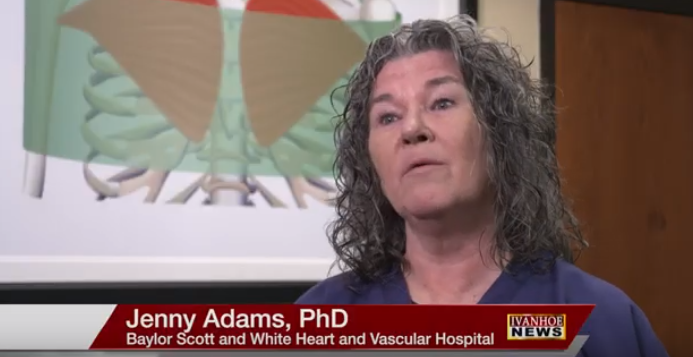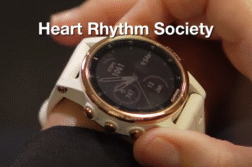Jenny Adams, PhD, Exercise Physiologist at Baylor Scott and White Heart and Vascular Hospital talks about cardiac rehab and how the “keep your move in the tube” philosophy is helping patients.
Interview conducted by Ivanhoe Broadcast News in February 2019.
Do you do a lot of research involving people who are in cardiac rehab?
JENNY ADAMS: My main focus right now is working with patients who have had a sternotomy, which is coronary artery bypass graft surgery and valve surgery and transplants.
Is that open heart surgery?
JENNY ADAMS: Yes.
That relates directly to this story we’re doing right? What is it called?
JENNY ADAMS: It’s called a sternotomy where they crack the sternum open so that they can pull the ribs back and work on the heart and then they tie the sternum back together with wires when they’re finished. After that the patient has to deal with that surgery when they’re doing activities.
What’s the name of this study that we’re looking at today?
JENNY ADAMS: It is a philosophy change called: keep your move in the tube.
What does it mean?
JENNY ADAMS: What it means is, traditionally in the 1970s when they first started getting discharge education packets together to tell patients what they could do after the surgery they told them not to lift more than five pounds. So that resulted in kind of an urban myth where they couldn’t lift their groceries, they couldn’t lift their grandkids, they couldn’t open doors. It causes problems with returning to work if you’re some kind of firefighter or police officer who has to lift things. It causes problems in getting out of bed in the hospital and getting out of a chair, which means you might not be able to go home and you might be discharged to a skilled nursing facility. There are all kinds of problems if someone tells you not to lift more than five pounds because we have actually measured a lot of things with a dynamometer like doors and a microwave button that was five pounds of pressure. Our own door to cardiac rehab is 15 pounds, which is a problem because they can’t even come into the cardiac rehab door since it weighs 15 pounds after they’ve been told not to lift more than five pounds. So it’s a ridiculous thing to say to people and it causes a lot of problems.
You call this a myth but it was based on what doctors thought at one time?
JENNY ADAMS: I think they were trying to be conservative because they didn’t know how much pressure the wires would take on the sternum. I understand why they started out in the 1970s saying five pounds, they probably wanted to go conservative but they didn’t have any evidence to back that number up. It became the urban myth and it stuck, and now everyone says it across the entire world.
They still say it?
JENNY ADAMS: Yes we say it. We said it’s all over; I’ve talked to people from all different countries because that’s all that they have. This new philosophy keep your move in the tube is what we’re trying to change so that they don’t say don’t lift more than five pounds anymore and they start to say keep your move in the tube.
What does keep your move in the tube mean?
JENNY ADAMS: It means, if I put an imaginary tube on your body, I will have no number that you can’t lift. You can lift anything you want as long as you keep your arms close to your body. Kind of like a T-Rex dinosaur. There is no amount of weight that you can’t lift, as long as you keep your arms close to your body because you’re not pulling on the sternum. We learned it’s not about the weight; it’s about keeping your arms close to your body. It’s very simple.
How long do you have to keep your move in the tube before the wires and everything starts healing?
JENNY ADAMS: We don’t say an amount of time anymore. They used to say don’t lift more than five pounds for 12 weeks. Now 12 weeks is a long time for a maintenance man or a firefighter to not go back to work. I had one guy who couldn’t lift his tool box because it weighed 25 pounds so he couldn’t go back to work. The reason for the tube is, as soon as you can start moving outside of it and you don’t have pain, you are OK. But the healing process is according to because everyone heals differently. We used to tell the same exact thing to everyone no matter how old or how strong they were but now we say it’s according to you. So, if you reach outside of the tube on day one and you don’t have pain, then you’re OK. If you have pain you get back in there. Basically you slowly start moving outside of the tube at your convenience and then when you don’t have pain you’re OK.
Is the patient coached by you and nursing technicians or other physical therapists to help them figure out their own limitations and their own capabilities?
JENNY ADAMS: In the inpatient setting; say it’s right the day after their surgery in the old days with the old way they would say don’t lift more than five pounds and demonstrate to us when they’re trying to figure out if they’re going to discharge them home or to an inpatient facility or a skilled nursing facility. They would tell them to sit on the side of the bed hold their arms up by their chest and they have on the hospital socks, they would tell them to walk and try to see if they can get out of bed. Sometimes people need to use their arms to push down to get them out of bed. So if they can’t get out of bed and they can’t get out of the hospital chair they don’t get to go home. But if you give them their arms back and tell them to keep their move in the tube then they can push down on their legs, chair or bed to get up and get to go home. That’s extremely important.
Why is it important?
JENNY ADAMS: Because there’s a lot of research that shows that the people who, at one year after surgery, have a higher possibility of being alive if they get discharged home. If you go to these other facilities, a lot of times there’s not a lot of movement going on there; not a lot of activity. You can catch infections there and there are all kinds of clinical reasons why you would rather go home and get back to work to get active. A lot of people will atrophy and then they become weaker when they’re in those facilities. So, just by giving people their arms back, they can come to cardiac rehab faster and we can continue using the tube in cardiac rehab by teaching them how to do weightlifting activities and all kinds of activities with their arms. Afterward they can return to work lab and we can get them back on their feet to keep them from atrophy which is very important.
What will be the net result of all of this?
JENNY ADAMS: Our most recent research study tested a thousand people; 500 got the tube and 500 got the traditional standard precautions. It showed an increase from 40 percent to 80 percent with sternum precautions got to go home when you just simply gave them their arms back. Now, that results in money change because there’s going to be bundled payments that come along and the hospital is going to have to pay for people who go to inpatient rehab and skilled nursing, and by the 40 percent increase in patients who got to go home, we saved the hospital one point five million dollars.
If people go back to work sooner then you’re going to have an impact on workers comp. But you had told me something about saving lives?
JENNY ADAMS: If you get discharged home you have a 95% chance of being alive at one year. In other words, going home saves lives.
Have you been involved in this national study?
JENNY ADAMS: Yes, it’s our study here.
Who came up with the concept of the study?
JENNY ADAMS: We came up with the study here at cardiac rehab.
Who named it?
JENNY ADAMS: I did. I needed a catchy phrase, and when I tried to explain to people to keep their arms by their side I tried to draw it on a piece of paper but I can’t draw. So I got an artist to make the graphic, and the graphic helps me explain the educational part of it. However, if you tell a patient to keep their arms close to their body you’re good to go.
For a person who’s just gone through this open heart surgery or procedure where their sternum is bust open and then wired back shut. What are the chances of that pulling apart?
JENNY ADAMS: We found out through research in the past that when you cough it is 60 pounds of pressure outward on your sternum. We did another study called the sneeze study and we forced people to sneeze while we had a force transducer in their esophagus, and we found out that when you sneeze it’s 90 pounds on your sternum. This means that one point five percent of people will have what they call sternal dehiscence. That does happen sometimes with people who have osteoporosis and people that cough a lot who are on ACE inhibitors. There are all kinds of reasons why someone might cause it to break, but it only happens one point five percent of the time so, while we are worried about that small percentage, the rest of patients are forced to not lift more than five pounds, which doesn’t make sense.
Are you saying these precautions from the past were made to protect one point five percent of incidents at the expense of ninety eight point five percent of the people who need to get working?
JENNY ADAMS: That’s what I am trying to say.
Turn it around; you don’t have to use the numbers.
JENNY ADAMS: Ninety eight point five is the opposite. At the expenses of the 1970s precaution of don’t lift more than five pounds due to the fear of dehiscence, you can get infections.
Then you might have to go back in there, right?
JENNY ADAMS: Yes. We have to go back in and stay longer in the hospital but they atrophy more. It’s just a cascade of terrible clinical outcomes if it happens. It only happens one point five percent of the time. So for the expense of the ninety eight point five percent of the rest of patients, to whom this is likely not going to happen to, they still enforce the don’t lift more than five pounds for 12 weeks precaution. This causes patients all kinds of problems in returning to work and activities of daily living.
END OF INTERVIEW
This information is intended for additional research purposes only. It is not to be used as a prescription or advice from Ivanhoe Broadcast News, Inc. or any medical professional interviewed. Ivanhoe Broadcast News, Inc. assumes no responsibility for the depth or accuracy of physician statements. Procedures or medicines apply to different people and medical factors; always consult your physician on medical matters.
If you would like more information, please contact:
Susan Hall, PR Baylor
214-820-1817
Sign up for a free weekly e-mail on Medical Breakthroughs called First to Know by clicking here




